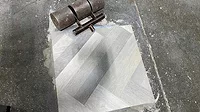How to Perform Stretch-in Carpet Installation Using Tack Strips

Make sure you have all the tools and supplies needed prior to installing your tack strip and carpet.
Photo: INSTALL.
Stretch-in installation is a popular method for installing wall-to-wall carpeting in residential and commercial spaces. Most installers know this technique involves stretching carpet over the subfloor and padding and securing the carpet in place with tack strips installed around the perimeter of the room. But it’s easy to get wrong, resulting in costly rework or damage to a flooring contractor’s reputation.
When performed by a trained installer, stretch-in installation eliminates unwanted wrinkles and movement in the carpet to optimize its appearance and long-term performance. This method is suitable for most carpet types, and it allows the carpet to be removed for easy replacement.
Reputable organizations that train and certify floorcovering professionals in carpet installation, like the International Standards & Training Alliance (INSTALL), follow standards set forth by The Carpet & Rug Institute (CRI). These standards provide detailed guidelines for both commercial and residential carpet installation, including stretch-in installation. The following steps are based on these standards and include expert tips from Michael Eisenhauer, an installation instructor at the Mid-America Carpenters Regional Council Apprentice and Training Center in St. Louis, Missouri. Mid-America Carpenters works in partnership with INSTALL to provide training for floorcovering installers.
Step 1: Ready the room.
Every professional floorcovering job should start with preparing the installation space. This includes removing old carpeting and padding and sweeping and vacuuming the subfloor to ensure it’s free of nails, staples and debris.
Michael’s Tip: Take care when cleaning the subfloor. Any missed debris will be trapped under the carpet and potentially seen or felt underfoot after the installation is complete.
Step 2: Install the tack strips.
Measure the perimeter of the room and cut the tack strips to fit along wall sections, door casings, and any other irregularities around the room. For residential settings, CRI requires tack strips to be a minimum of 1 inch wide and ¼ inch thick for installations less than 30 feet long. Architectural tack strips with 3 rows of pins and at least 1 ¼ inches wide should be used for installations over 30 feet. Alternatively, the installer can double-up standard 1 inch plywood strips to achieve the same results. The extra rows of pins are necessary to provide additional strength for stretching larger installations. For commercial settings, architectural tack strips or doubling-up are required for the entire installation.
Position the tack strips around the room’s perimeter with tacks angled toward the wall. Leave a gap between the tack strip and perimeter that is slightly less than the thickness of the carpet. Nail the tack strips to the subfloor and check that they are firmly attached, especially at the corners and where individual sections of the tack strip meet. Pre-nailed tack strips are commonly used, and all pieces should be anchored 1 inch from each end to ensure the strip remains firmly in place and holds the stretch. If installing carpet over a radiant-heated floor, do not use nails or screws. Instead, use an adhesive that is approved for securing tack strips.
Michael’s Tip: The gap between the tack strip and the wall or vertical abutment is called the gully. For optimal results, ensure the gully is ¼ inch to ⅜ inch wide. The measure you select should be slightly less than the carpet thickness. If the gully is too wide, the carpet will not be flush. If the gully is too narrow, it will be difficult to hook and tuck the carpet in the later steps of installation.
Step 3: Install the carpet padding.
Measure and cut the carpet padding to fit the area inside the tack strips. Do not cover the tack strips with the padding. Staple the padding to the subfloor along the edges near the tack strips. For a concrete subfloor, use adhesive instead of staples. Trim any excess padding as needed.
Michael’s Tip: To align with CRI standards, carpet padding for residential installations should not exceed 7/16 inch thick and commercial installations should not exceed ⅜ inch thick.
Step 4: Lay the carpet.
Measure the room and cut the carpet to size, allowing a few extra inches on each side for trimming. Place the carpet over the padding and position it so that it’s smooth and centered in the room. Once in the desired position, use a knee kicker to position the carpet onto the tack strips along one edge of the room and then use a power stretcher to stretch the carpet to the opposite side. Refer to CRI 104 Carpet Installation Standard for Commercial Carpet or CRI 105 Carpet Installation for Residential Carpet for a diagram and step-by-step instructions on the stretching order and direction stretch. When the carpet is fully stretched, smoothed, and hooked onto all of the tack strips, trim the excess carpet along the walls with a carpet trimming tool, or a carpet knife.
Michael’s Tip: Generally, a tufted carpet with a synthetic backing should be stretched a minimum of 1.5% to 2% of its length and width. Different carpets require different amounts of stretching, so for best results consult the carpet manufacturer for instructions.
Step 5: Tuck and finish.
Use a non-marring carpet tucking tool to tuck the carpet’s edge neatly into the gully between the tack strips and the wall. If needed, install the appropriate transition strips in doorways or where the carpet meets another type of flooring. Finally, vacuum the carpet to clean up any loose fibers or installation scraps.
Michael’s Tip: Vacuuming the carpet is a nice final touch to perk up the carpet after installation.
Looking for a reprint of this article?
From high-res PDFs to custom plaques, order your copy today!




.webp?t=1690771780)

